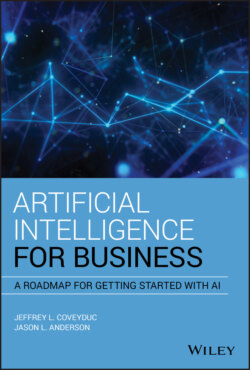Читать книгу Artificial Intelligence for Business - Jason L. Anderson - Страница 5
Preface
ОглавлениеArtificial intelligence (AI) has become so ingrained in our daily lives that most people knowingly leverage it every day. Whether interacting with an artificial “entity” such as the iPhone assistant Siri, or browsing through Netflix's recommendations, our functional adoption of machine learning is already well under way. Indirectly, however, AI is even more prevalent. Every credit card purchase made is run through fraud detection AI to help safeguard customers' money. Advanced logistical scheduling software is used to deliver tens of millions of packages daily, to locales around the world, with minimal disruption. In fact, the e-commerce giant Amazon alone claims to have shipped 5 billion packages with Prime in 2017 (see businesswire.com/news/home/20180102005390/en/). None of this would be possible on such a grand scale without the advances we have seen in AI systems and in machine learning technology over the last few decades.
Historically, these AI systems have been developed in-house by skilled teams of programmers, working around the clock at great expense to employers. This reality is now changing. Companies like IBM, Google, and Microsoft are making AI capabilities available on a pay-as-you-go basis, dramatically lowering the barrier to entry. For example, each of these companies provide speech-to-text and text-to-speech services to easily build voice interfaces for pennies per use. This is opening the door for smaller companies with less disposable capital to introduce AI initiatives that will produce substantial results. With the aforementioned backdrop of consumers interacting with AI on a daily basis, these consumers are becoming increasingly more comfortable and receptive to their brands adopting and incorporating more AI technology. The combination of all of these components makes it a smart bet for any modern company to start down the road toward AI adoption.
But how do these companies get started? This question is one we have seen time and again working with clients in the AI space. The drive and enthusiasm are there, but what organizational thought leaders are missing is the “how to” and overall direction. In our day jobs working with IBM Watson Client Engagement Centers and clients around the world, we repeatedly saw this pattern play out. Clients were eager to incorporate AI systems into their business models. They understood many of the benefits. They just needed a way in. While attending tech conferences and meetups, we find similar stories as well. Though the technological barriers are lower, with vendors providing accessible AI technology in the cloud, the challenge of coming up with the overall plan was still preventing many businesses from adopting AI. Having a good roadmap is essential to feeling comfortable with starting the journey. It is for this very reason that we wrote this book. Our goal is to empower you with the knowledge to successfully adopt AI technology into your organization. And you've already taken the first step by opening this book.
In addition to helping you adopt and understand emerging AI technology, this book will give you the tools to use AI to make a measurable impact in your business. Perhaps you will find some new cost-saving opportunities to unlock. Maybe AI will allow your business to uniquely position itself to enter new markets and take on competitors. Although AI has become more widespread and mainstream in its use in recent years, we are still seeing a tremendous amount of room for disruption in every field. That's the great thing about AI—it can be applied in an interdisciplinary fashion to all domains, and the more it grows, the more its capabilities grow along with it. All that we ask of you, the reader, is to start with an open mind while we provide that missing roadmap to help you successfully navigate your way to driving value within your organization using AI.
